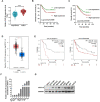CXCL16 Promotes Gastric Cancer Tumorigenesis via ADAM10-Dependent CXCL16/CXCR6 Axis and Activates Akt and MAPK Signaling Pathways
- PMID: 34345211
- PMCID: PMC8326113
- DOI: 10.7150/ijbs.57826
CXCL16 Promotes Gastric Cancer Tumorigenesis via ADAM10-Dependent CXCL16/CXCR6 Axis and Activates Akt and MAPK Signaling Pathways
Erratum in
-
Erratum: CXCL16 Promotes Gastric Cancer Tumorigenesis via ADAM10-Dependent CXCL16/CXCR6 Axis and Activates Akt and MAPK Signaling Pathways: Erratum.Int J Biol Sci. 2023 Jun 21;19(10):3285-3287. doi: 10.7150/ijbs.84342. eCollection 2023. Int J Biol Sci. 2023. PMID: 37416762 Free PMC article.
Abstract
Abnormal expression of CXC motif chemokine ligand 16 (CXCL16) has been demonstrated to be associated with tumor progression and metastasis, served as a prognostic factor in many cancers, with higher relative expression behaving as a marker of tumor progression. However, its role and mechanisms underlying progression and metastasis of gastric cancer (GC) are yet to be elucidated. In our investigation, public datasets and human GC tissue samples were used to determine the CXCL16 expression levels. Our results revealed that CXCL16 was upregulated in GC. The high expression CXCL16 in GC was significantly associated with histologic poor differentiation and pTNM staging. And high CXCL16 was positively correlated with the poor survival of GC patients. Gain-and loss-of-function experiments were employed to investigate the biological role of CXCL16 in proliferation and migration both in vitro and in vivo. Mechanically, Gene set enrichment analysis (GSEA) revealed that the epithelial‑mesenchymal transition (EMT), Akt and MAPK signal pathway related genes were significantly enriched in the high CXCL16 group, which was confirmed by western blot. Moreover, overexpression CXCL16 promoted the disintegrin and metalloproteases (ADAM10) and the CXC motif chemokine receptor 6 (CXCR6) expression, which mediated the CXCL16/CXCR6 positive feedback loop in GC, with activating Akt and MAPK signaling pathways. Knocking down ADAM10 would interrupted the CXCL16/CXCR6 axis in the carcinogenesis and progression of GC. In conclusion, our findings offered insights into that CXCL16 promoted GC tumorigenesis by enhancing ADAM10-dependent CXCL16/CXCR6 axis activation.
Keywords: ADAM10; CXCL16; gastric cancer; tumorigenesis.
© The author(s).
Conflict of interest statement
Competing Interests: The authors have declared that no competing interest exists.
Figures






Similar articles
-
CXCR6 predicts poor prognosis in gastric cancer and promotes tumor metastasis through epithelial-mesenchymal transition.Oncol Rep. 2017 Jun;37(6):3279-3286. doi: 10.3892/or.2017.5598. Epub 2017 Apr 25. Oncol Rep. 2017. PMID: 28440473
-
Prostate cancer cells hyper-activate CXCR6 signaling by cleaving CXCL16 to overcome effect of docetaxel.Cancer Lett. 2019 Jul 10;454:1-13. doi: 10.1016/j.canlet.2019.04.001. Epub 2019 Apr 8. Cancer Lett. 2019. PMID: 30974114 Free PMC article.
-
CXCL16/CXCR6 axis promotes bleomycin-induced fibrotic process in MRC-5 cells via the PI3K/AKT/FOXO3a pathway.Int Immunopharmacol. 2020 Apr;81:106035. doi: 10.1016/j.intimp.2019.106035. Epub 2019 Nov 19. Int Immunopharmacol. 2020. PMID: 31753588
-
The Role of CXCL16 in the Pathogenesis of Cancer and Other Diseases.Int J Mol Sci. 2021 Mar 28;22(7):3490. doi: 10.3390/ijms22073490. Int J Mol Sci. 2021. PMID: 33800554 Free PMC article. Review.
-
The role of the CXCR6/CXCL16 axis in the pathogenesis of fibrotic disease.Int Immunopharmacol. 2024 May 10;132:112015. doi: 10.1016/j.intimp.2024.112015. Epub 2024 Apr 11. Int Immunopharmacol. 2024. PMID: 38608478 Review.
Cited by
-
Targeting ETHE1 inhibits tumorigenesis in vitro and in vivo by preventing aerobic glycolysis in gastric adenocarcinoma cells.Oncol Lett. 2025 Apr 10;29(6):286. doi: 10.3892/ol.2025.15032. eCollection 2025 Jun. Oncol Lett. 2025. PMID: 40264823 Free PMC article.
-
Chemokine/GPCR Signaling-Mediated EMT in Cancer Metastasis.J Oncol. 2022 Oct 11;2022:2208176. doi: 10.1155/2022/2208176. eCollection 2022. J Oncol. 2022. PMID: 36268282 Free PMC article. Review.
-
C-C Motif Chemokine Ligand-17 as a Novel Biomarker and Regulator of Epithelial Mesenchymal Transition in Renal Fibrogenesis.Cells. 2021 Nov 29;10(12):3345. doi: 10.3390/cells10123345. Cells. 2021. PMID: 34943853 Free PMC article.
-
A novel Tc17 population recruited by tumor cells promotes tumor progression in gastric cancer.Front Oncol. 2025 May 16;15:1592328. doi: 10.3389/fonc.2025.1592328. eCollection 2025. Front Oncol. 2025. PMID: 40452847 Free PMC article.
-
Tumor-associated macrophages promote cisplatin resistance in ovarian cancer cells by enhancing WTAP-mediated N6-methyladenosine RNA methylation via the CXCL16/CXCR6 axis.Cancer Chemother Pharmacol. 2023 Jul;92(1):71-81. doi: 10.1007/s00280-023-04533-8. Epub 2023 Jun 5. Cancer Chemother Pharmacol. 2023. PMID: 37272931 Free PMC article.
References
-
- Bray F, Ferlay J, Soerjomataram I. et al. Global cancer statistics 2018: GLOBOCAN estimates of incidence and mortality worldwide for 36 cancers in 185 countries. CA Cancer J Clin. 2018;68:394–424. - PubMed
-
- Sano T. Gastric cancer: Asia and the world. Gastric Cancer. 2017;20:1–2. - PubMed
-
- Van Cutsem E, Sagaert X, Topal B. et al. Gastric cancer. Lancet. 2016;388:2654–64. - PubMed
-
- Baggiolini M. Chemokines and leukocyte traffic. Nature. 1998;392:565–8. - PubMed
Publication types
MeSH terms
Substances
LinkOut - more resources
Full Text Sources
Medical
Miscellaneous

